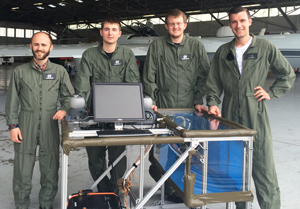UNMC made history last week when a UNMC surgery fellow and three University of Nebraska-Lincoln students dressed in flight suits boarded a 727 jet modified for zero-gravity experiments with NASA.
 |
Anton Simorov, M.D., practices surgical techniques with the mini surgical robot. |
But the robots that fit inside the abdomen were developed for NASA to close medical gaps in space — something a flight surgeon could use in an emergency.
The next frontier for testing would have to be space – at least a simulation of space.
Anton Simorov, M.D., UNMC surgery fellow, and UNL engineering students Kearney Lackas, Walter Bircher and Tom Frederick took off from Johnson Space Center in Houston on a parabolic flight operated by Zero Gravity Corporation.
 |
From left to right: UNL engineering graduate students Walter Bircher, Kearney Lackas and Thomas Frederick and UNMC surgical fellow, Anton Simorov, M.D. |
Dr. Simorov practiced surgical techniques during 80 separate 20- to 30-second weightless periods, while engineering students monitored equipment.
“We accomplished our experiment goals. We collected a lot of data which will take several weeks to process and analyze,” Dr. Simorov said. “We learned a lot to further our experiments. It was a great, unforgettable experience.”
The flight was the result of a 2013 visit by a NASA team to learn about university research with potential applications in space, said Marsha Morien, executive director of the UNMC Center for Advanced Surgical Technology. “The NASA visitors saw the project and said it was ready for flight testing. Getting this flight is amazing. It’s highly competitive.”
On the other hand…
Dmitry Oleynikov, M.D., co-inventor of the mini-surgical robots, explained why he wasn’t on the test flight. “Every part of me wanted to be launched into an airplane that flies as high as 34,000 feet and then plummets to earth in an uncontrolled fall and is referred to by the people who fly it as the ‘vomit comet.’ I just couldn’t get away — I’m just too busy,” he joked.
Dmitry Oleynikov, M.D., a co-inventor of the robots, said the flight was a big step.
“We’re very excited. We’ve always felt it was a good idea to take a surgical platform, miniaturize it and use it in places you can’t have a hospital,” said Dr. Oleynikov, director of the Center for Minimally Invasive Surgery and the Center for Advanced Surgical Technology at UNMC. “It’s a natural extension of that concept to use it in space, on the battlefield and in other remote areas.”
Shane Farritor, Ph.D., UNL professor of mechanical and materials engineering and the robots’ co-inventor, said the flight moved the research forward. “It was a great learning experience for the students who successfully deployed a complex field system and operated it in a unique environment. We have more to do, but I really like where we are.”
